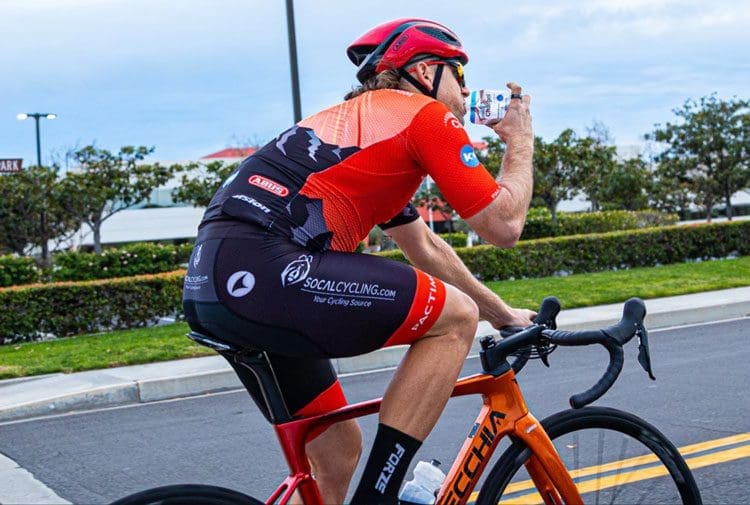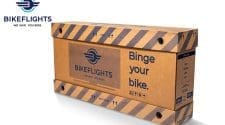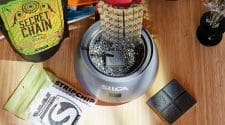Energy Gels: What they are and how they
can help you perform like a champ

Matthew “Matt” Kadey is a registered dietitian based in Waterloo, Ontario, Canada who specializes in nutrition pieces and recipe development. Matt is a contributing health writer whose pieces and photography has appeared in a range of online and print publications such as Men’s Health, Women’s Health, Runner’s World, Clean Eating and more.
His work in food journalism earned him a James Beard Award in 2013. He’s published three cookbooks and his philosophy centers on consuming whole foods and getting plenty of exercise so you can eat more of them. You can learn more about Matt by going to www.matthewkadey.com or following along on Instagram and Facebook, @rocketfuelfood, @bt700bikepacking, facebook.com/rocketfuelfoods and Facebook.com/BT700.
These days, there is no shortage of products that are designed to help keep us fuelled during our athletic pursuits. From energy bars to sports drinks to chews, there are many options for gassing up the engine. Another prominent option that is popular with athletes of all stripes are so-called ‘energy gels.
If you’re a long-distance runner, cyclist or any kind of endurance athlete, you may have heard about and likely used the gooey nutrition. For many athletic-minded individuals, energy gels are part of their sports nutrition strategy. But what if there was a better option to fuel your athletic pursuits?
What are these products and what is the best way to use them? And where can you improve upon your standard gel? Let us explain.
What is a gel?
In simple terms, an energy gel is a product with a gel-like texture that is designed to provide a burst of carbohydrate energy during endurance exercise like running or cycling and, in doing so, help evade the dreaded bonk. For the most part, they are made from a blend of easy-to-digest simple carbohydrates like the dextrin and sugar you’ll find in a Chargel gel drink that allows you to get the most out of your workouts and races. And they are typically more concentrated in carbohydrate calories than sports drinks and energy chews. Products are designed to be free of fat, fiber or protein – so your body digests them quickly and there is less risk for GI distress when you are trying to push the pace. Simple to consume, not filling and easily digestible. Exactly what you want in a sports fuel.
Other ingredients can include B vitamins, amino acids and salt. Most products, including Chargel, come in small, take-anywhere packets, which make them convenient and easy to consume before and/or during a long-distance physical effort.
How does a gel drink like Chargel work?
When you exercise vigorously, your body draws on carbohydrates in the form of glycogen stored in your muscles as the primary source of energy. However, this vital energy source is fleeting and can be depleted quicker than one would like. Rarely, will glycogen last much longer than 2 hours when pushing a moderate pace. That is where sports nutrition products like gels and gel drinks come to the rescue.
The fast-acting carbohydrates in gels function to help keep blood sugar levels from dropping too low and delay draining precious stored glycogen during exercise resulting in longer endurance and an added performance benefit. The simple carbohydrates can be metabolized quickly when working your muscles, giving them a useful energy source when pushing the pace. Keeping blood sugar elevated during exercise could also benefit brain function, resulting in improved mental performance such as concentration and reaction time. To note, your brain relies on the sugar in your blood as its preferred energy source.
Now, the unique benefit of Chargel is that it comes bundled with additional liquids that you won’t get with your standard energy gels. This serves three purposes:
- It improves texture making it easier to swallow when you are on the go
- It dilutes the sugar concentration, which results in improved digestion rates for quicker energy and less risk of stomach woes. Many athletes will experience what is not-so-lovingly called ‘gut rot’ when they take in too many regular gels and don’t wash these down with enough water.
Who should use gels and gel drinks?
Runners, cyclists, cross-country skiers or anyone who exercises continuously for lengthy periods can benefit from the near-instant, pick-me-up, energy rush that a gel-like product such as Chargel can provide. Additionally, new research suggests that even those who opt for resistance training can see improved results by consuming a source of fast-acting carbohydrates when performing long workouts.
How to use gels and gel drinks?
To stay energized from start to finish, sports nutrition science suggests it’s wise to consume a gel product every 45 minutes along the way for activities that are lasting longer than 60 minutes. (As long as you’ve consumed an adequate amount of carbs in your diet, it’s generally not necessary to supplement with carbs for workouts lasting less than 45 minutes.) To prevent glycogen depletion and keep from bonking, The American College of Sports Medicine says you’ll want to consume between 30 and 60 grams of carbohydrates for each hour of activity. This is the level of carbs in 1 to 3 gels, depending on the brand.
There are a handful of products on the market, like Chargel, that offer higher levels of carbs so that you can divi up the serving size. A single serving, if you’re really looking for a big dose of carbs or two or more servings if you want to break up your energy intake.
Using a gel or gel drink before a workout is another opportunity to top up your energy reserves. So if you are gearing up for a hard workout you could try using a product 15 to 30 minutes before working up a sweat.
How to choose the best product?
For more efficient absorption, look for gel brands that have two different forms of simple carbohydrates. This allows for different sugar transporters to function in the body making it easier for you to absorb a higher level of carbs and, in turn, burn more of them for energy. This is why Chargel includes both dextrin and sugar as their carbohydrate sources.
Many gels also offer some sodium, which becomes crucial when you are working up a serious sweat. While B vitamins such as thiamine don’t directly provide energy themselves, they could be a useful addition to a gel because they’re needed for cells to break down carbs for energy.
Bonus points if the product is third-party tested and certified including Informed Choice so it won’t contain any banned substances and delivers only what is on the ingredient list.
Of course, you’ll need to choose a product that you enjoy consuming. If you bring along a flavor that does not please your taste buds then it’s less likely you will use it and that is not conducive to achieving brag-worthy results. Luckily, you can now find some new products on the market that are different from other existing gels, with a more refreshing and unique texture and taste.
On a final note, always keep in mind that if you’re an endurance athlete training for competition, you need to devise a fueling strategy that works for you and practice it during your training regimen before race day.
To learn more about Chargel visit Chargel.com.
No products found.


















